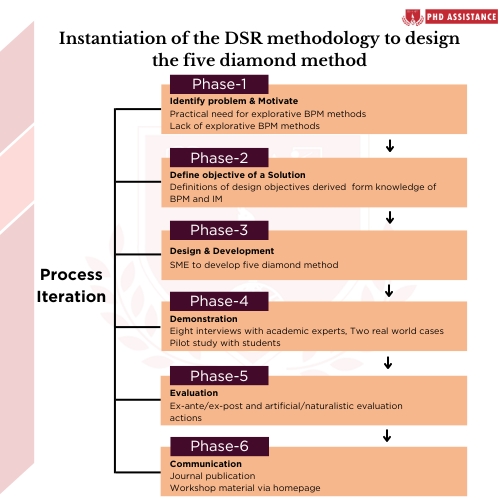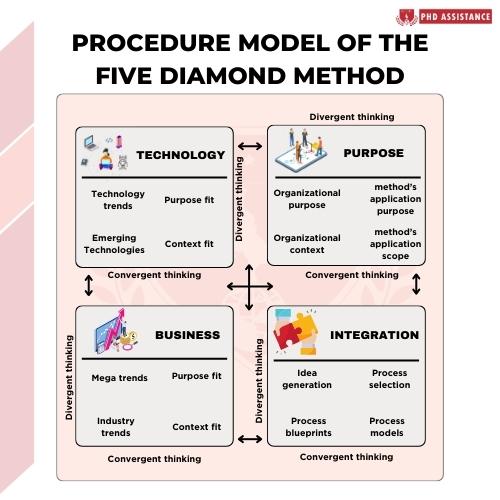Innovations in Business Process Management: Integrating Five Diamond Research Methods
Introduction
Explorative business process management (BPM) is gaining popularity as companies realize that operational efficiency is no longer enough when disruptive forces might render whole systems outdated. The Five Diamond Method, which is based on design science research and situational method engineering, is intended to steer exploratory BPM operations by recognizing opportunities from business and technology trends and integrating them into business processes with unique value propositions. The technique is assessed against design objectives supported by literature, competing artefacts, qualitative data, a pilot study, and two real-world implementations. The research design contributes by widening the scope of BPM through the incorporation of prescriptive knowledge from innovation management and assisting in the capture of emerging possibilities from changing consumer wants and digital technology.
Significance of BPM in modern organizations
Business process management (BPM) helps organizations operate effectively and efficiently through the continuous discovery, execution, analysis, and redesign of business processes. To that aim, a diverse collection of BPM research methodologies and tools aid in achieving stability, efficiency, and effectiveness by leveraging various redesign rationales (Gross et al. in press). These techniques, like the idea of organizational ambidexterity, can be broadly categorized as exploitative. They frequently overlook fresh prospects for innovation. Exploratory BPM solutions for proactively incorporating possibilities with unique value propositions into company processes have received little attention.
Check our PhD Research methodology examples to learn about how we review or edit an article for Research Methodology.
Principles of the Five-Diamond Method
The Five Diamond Method is a systematic and complete method of Explorative Business Process Management (EBPM), providing businesses with a defined purpose and direction. Its major purpose is to improve an organization’s processes’ efficiency, effectiveness, and agility. This technique provides a path for discovering, evaluating, and optimizing business processes by breaking down the EBPM journey into five separate steps – Discovery, Mapping, Analysis, Design, and Implementation. It enables companies to make primary data-driven choices, eliminate inefficiencies, improve customer happiness, and quickly adjust to changing market dynamics. Finally, the Five Diamond Method helps firms attain more competitiveness and long-term success in today’s volatile economic environment.
Research methods
The methodology of the Study must achieve explorative BPM by methodically discovering new value propositions for business processes. The Five Diamond approach is an exploratory BPM approach that they developed. The technique uses the DSR methodology, which consists of six phases: issue identification, design objective formulation, design and development, demonstration, assessment, and communication (Fig. 1).

The technique, which connects the Five Diamond technique to method qualities (goal orientation, systematic approach, primary orientation, repeatability), supports businesses in recognizing and integrating possibilities into new business processes to generate new value propositions. As a result, it involves multiple actions portrayed as one overarching diamond and four underneath diamonds.
The four diamonds represent (1) purpose, (2) business, (3) technology, and (4) integration. The diamond form of these activities illustrates the usage of divergent and convergent thinking during the process, which is drawn from innovation management.
- Purpose Diamond
The goal of the purpose diamond is to uncover the underlying motivation of organizational operations. As a result, it shifts the focus from what the company is doing now to what drives and inspires its business. Activity 1 is carried out by BPM stakeholders (e.g., BPM manager, process consultant) and (senior) managers who are familiar with or even participating in strategic goal planning.
- Business Diamond
The goal of the business diamond is to uncover possibilities that arise from the corporate environment. Several BPM-related stakeholders (e.g., BPM manager, process consultant), as well as BPM-unrelated stakeholders (e.g., business and market analysts, business developer), are engaged.
- Technology Diamond
The technology diamond tries to capitalize on digital technology potential. As a result, both BPM-related stakeholders (e.g., BPM manager, process consultant) and BPM-unrelated stakeholders (e.g., technology or digitalization expert) are involved.
- Integration Diamond
To discover and build creative process concepts, the integration diamond combines recognized possibilities with a BPM perspective. BPM specialists best accomplish this in collaboration with innovation managers, project portfolio managers, and senior management.

Limitations and Future Research
Limitations of the Five Diamond Method may encompass challenges related to data quality, as accurate and comprehensive data are crucial for its success. Organizational resistance to change and resource constraints can impede implementation. Future research can focus on below aspects which is still unexplored by researchers
- Refining data management practices and developing advanced data analytics tools for better decision-making within the method.
- Exploring strategies to address change management and scalability issues would enhance its effectiveness.
- Research on tailoring the Five Diamond Method for specific industries or sectors can provide valuable insights into its adaptability and optimization potential across diverse business environments.
Conclusion
The integration of Five Diamond Research Methods has significantly revolutionized the landscape of Business Process Management (BPM), fostering a culture of continuous innovation and heightened efficiency. This convergence has unleashed a new era of data-driven decision-making, where organizations harness the power of advanced analytics, artificial intelligence, and machine learning to optimize operations and enhance overall performance. By leveraging these progressive techniques, businesses can now streamline complex processes, mitigate risks, and capitalize on emerging opportunities, thus achieving sustainable growth and maintaining a competitive edge in today’s dynamic market. Our findings show the benefits of synthesizing adjacent research streams, i.e., BPM and IM, to broaden the scope of established knowledge on BPM. We call for more cross-disciplinary research, enabling BPM to provide the guidance needed in the digital age.
Check out our study guide to learn more about problem identification in the research process
About PhD Assistance
At Ph.D. assistance, we write your complete Ph.D. research methodology or develop the best research proposal that would guarantee your grade. We offer professional PhD research methodology services for a wide range of subjects for researchers struggling or stuck on analyzing certain aspects such as research design, sample size, power calculation, qualitative and quantitative methodology, primary & secondary data collection etc. We have specialized academicians who are professional and qualified in various specializations.
References
- Grisold, T., Groß, S., Stelzl, K. et al.The Five Diamond Method for Explorative Business Process Management. Bus Inf Syst Eng 64, 149–166 (2022). https://doi.org/10.1007/s12599-021-00703-1
- Röglinger, Maximilian, et al. “Exogenous shocks and business process management: a scholars’ perspective on challenges and opportunities.” Business & Information Systems Engineering5 (2022): 669-687.
- Denner, Marie-Sophie, Louis Christian Püschel, and Maximilian Röglinger. “How to exploit the digitalization potential of business processes.” Business & Information Systems Engineering60 (2018): 331-349.



